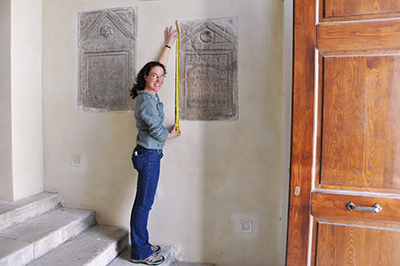 Menu
Menu

By Maureen Horan Benes, BA ’03
We sat down with Associate Professor of Classics Elizabeth Robinson, Ph.D., to discuss her new book, Urban Transformation in Ancient Molise: The Integration of Larinum into the Roman State.
The town has been inhabited since at least the ninth century BCE, making it ideal for my study of how local people adapted to the Roman conquest over multiple generations. The site provides a wealth of evidence: Larinum appears often in historical sources, its territory has been the subject of several archeological field surveys, it has an extensive epigraphic record (with over 250 inscribed stones listing the names and careers of residents), and excavations have taken place in key areas of the town. To tell as complete a story as possible, I combined all that evidence.
My favorite discovery occurred in May of 2010 while I was living in the town of Larino, the modern town that sits atop the remains of Larinum. I was photographing inscribed stones walled into the town hall. The local priest, who had just bought parsley at the market in the adjacent town square, asked me if I had seen the stone in Signora Ficocelli’s house. When I went to visit her, Signora Ficocelli explained the stone had been found while plaster was being cleaned off a wall. When she moved the door that blocked the stone, I read the Oscan words “MATREIS.HANU / O.MAMERTEI.ECO.” Oscan was spoken in Larinum before the Roman conquest, and I at once recognized the name “Mamert-” as the Oscan version of Mars, the war god.
I contacted an Oscan expert, Timo Sironen, and we worked together to publish an article on the discovery. He proposed the translation “small shrine of Mater/Mother / to Mars [someone dedicated?] this.” The stone is the only inscription dedicated to Mars ever found at the site, and it fills in an historical gap. Cicero talks about the antiquity and importance of the cult of Mars in Larinum in his Pro Cluentio, and this inscription shows that Mars was honored in the native language of the town before Larinum gained Roman citizenship.
My study is part of a trend of recent research that moves away from broad studies of regions to focus on individuals and individual towns. For the layperson, the story of the Roman conquest can sound like the Roman army was a kind of war machine tearing through conquered territories, but scholarly research shows this just wasn’t the case. In Larinum, an Oscan-speaking town that had interacted with Rome but was largely independent until the conquest, the effects of Rome’s victory were quite different from those seen elsewhere, such as in Etruria and Lucania. The inclusion of Larinum’s story in broader narratives emphasizes continuity and the agency of local individuals and families.
Larinum’s urbanization is one of the reasons why it integrated so successfully into the Roman state after the Social War and continued to thrive until at least the third century C.E. Just before the Romans came, Larinum built a town wall, laid out an orthogonally planned street grid, and minted coins. In the third and second centuries B.C.E., there was a sanctuary associated with economic activities near the center of the town. A forum-like public space was used as early as the third century B.C.E. By the second century C.E. (after my period of study ends), Larinum had a forum, baths and an amphitheater — buildings that you’d expect to find in any typical Roman town. But the story of how it got to that point is fascinating. It's the story of residents deciding to honor their town by building these monuments.
It’s one thing to read about a place and look at maps, and it’s quite another to put your feet on the ground and walk around. I was fortunate to receive several grants and fellowships to live in Larino and study Larinum. I had long conversations with people that led to new discoveries such as the Oscan inscription. I got to know Napoleone Stelluti, a local archaeological enthusiast who shared his work on inscriptions.
I made occasional visits to the offices of the Soprintendenza Archeologia, Belle arti e Paesaggio del Molise. The inspectors there gave me copies of their publications on Larinum and shared their time and knowledge with me — including helping me find pottery from earlier field surveys. I wouldn’t have been able to write the book I did without their support and guidance. The people of Larino (and the broader region of Molise) were so kind and welcoming to me. I think it’s safe to say that it would have been impossible to write a book of this kind without actually being present in Larino.
Urban Transformation in Ancient Molise is available through Oxford University Press and amazon.com. Read a review of the book in the American Journal of Archaeology.
Robinson will give a book presentation on UD’s Eugene Constantin Campus in Rome on April 20.